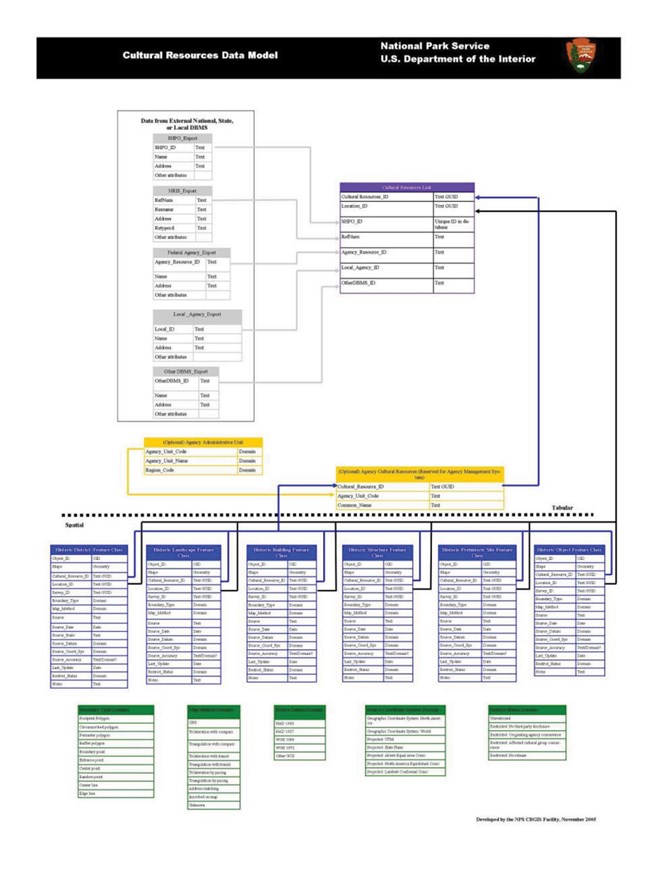Last updated: March 29, 2024
Article
NPS Cultural Resources Data Transfer Standards
Return to CRGIS Home
The National Park Service (NPS) was designated as the lead agency to develop standards for cultural resources spatial data in 2002 (OMB Circular A-16). The Cultural Resources GIS Facility (CRGIS) became the principal program to fulfill this mandate. By 2008, the Federal Geographic Data Committee (FGDC) unanimously voted to sponsor the development of Federal-wide mandatory spatial data standards for cultural resources under the leadership of CRGIS.
CRGIS works with the NPS GIS Council, NPS Cultural Resources Subcommittee, and collaborates with NPS programs and partners to develop and refine the standards for GIS data exchanges within the park service. Training and guidance for parks, regions, and programs is available through CRGIS as the standards are utilized throughout divisions and parks.
The National Park Service (NPS) was designated as the lead agency to develop standards for cultural resources spatial data in 2002 (OMB Circular A-16). The Cultural Resources GIS Facility (CRGIS) became the principal program to fulfill this mandate. By 2008, the Federal Geographic Data Committee (FGDC) unanimously voted to sponsor the development of Federal-wide mandatory spatial data standards for cultural resources under the leadership of CRGIS.
CRGIS works with the NPS GIS Council, NPS Cultural Resources Subcommittee, and collaborates with NPS programs and partners to develop and refine the standards for GIS data exchanges within the park service. Training and guidance for parks, regions, and programs is available through CRGIS as the standards are utilized throughout divisions and parks.
CRGIS serves as the National Geospatial Data Assets’ (NGDA) Cultural Resources Theme Lead for the Federal Geospatial Data Committee (FGDC) and maintains accountability for the dissemination and accessibility of federal and national datasets including the NPS’s own National Register of Historic Places Spatial data. Learn more about the FGDC, GDA, and Cultural Resources Theme here.
The data transfer standards have helped to develop an National Cultural Resources GIS Dataset at the National/Enterprise-level. Operating via an ArcGIS Enterprise dataset serves to represent cultural resources in geographic methodologies while supplying accessibility to the data and maintaining security measures for sensitive information. The use of the CR Standards helps to provide a mechanism for displaying relationships about these resources between the various databases and programs. Access the ArcGIS Geodatabase template of the NPS CR Standards here.
The data transfer standards have helped to develop an National Cultural Resources GIS Dataset at the National/Enterprise-level. Operating via an ArcGIS Enterprise dataset serves to represent cultural resources in geographic methodologies while supplying accessibility to the data and maintaining security measures for sensitive information. The use of the CR Standards helps to provide a mechanism for displaying relationships about these resources between the various databases and programs. Access the ArcGIS Geodatabase template of the NPS CR Standards here.

Cultural Resources GIS Facility, NPS
About the Standards
The NPS Cultural Resource Spatial Data Transfer Standards are intended to provide a framework for organizing agency cultural resource spatial data, documenting its lineage, and facilitating data integration as well as data sharing.National Park Service GIS Council established formal procedures for creating internal standards and approved the Cultural Resource Spatial Data Transfer Standards in February 2010 as the Federal Lead under the FGDC. Once internal standards were created, Federal agency-wide standards were developed following the OMB Circular A-16 FGDC compliance.
The primary benefit for using the standards remains the organization and documentation of cultural resource data to allow users to share spatial data between parks, parks and regions, among regions, between parks/regions and programs and among programs. The standards help insure spatial data consistency, quality, and accuracy. Using location as a way of linking these 15 existing directorate cultural resource databases together, further allows users to explore all facets of a cultural resource in ways that are not currently possible.
Access the Standards
The NPS Cultural Resource Data Transfer Standards address only the spatial representation of cultural resources and the accuracy of the feature level metadata, which describes how each of the spatial entities was created. The standards do not address descriptive information already captured in existing NPS cultural resources databases. The standards do establish a series of 18 data layers based on National Register of Historic Places cultural resource types, as well as 34 fields of feature level metadata to describe the geographic parameters of each feature and how they relate to individual parks/regions.To ensure compliance, a geodatabase model accompanies the standards, which provides a platform for parks, regions, and programs to quickly migrate their data into a structure for accurate data sharing. The standards guidance document will be updated as needed with technology evolvements. Access the standards guidance documents here.
